Many different types of specialized containers—from small boxes to sizable pieces of furniture—were created for storing wine bottles and other drinking accoutrements. Such containers typically found homes in elegant dining rooms or parlors. The English artist, Joseph Farington, records in his diary details of an 1801 dinner party he attended.
We were very hospitably entertained. — After the Dinner was removed, before the fruit was put on, a Case of liquers was placed before Mrs. Bell who helped her guests to small glasses of Cherry Brandy — Lemon Brandy &c &c as they liked.— This is a Scottish custom & the Ladies partake of it. The fruit and cheese were put on together in the 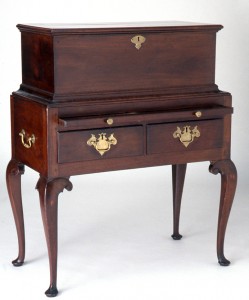 French manner before the Cloth was taken off.
French manner before the Cloth was taken off.
Cellarette or bottle chest on stand
Northampton County, North Carolina; 1755–70
Black walnut, yellow pine, brass
Museum purchase and gift of Mr. and Mrs. John R. Donnell, Mr. and Mrs. P. Coleman Townsend, Miss Milly McGehee, and Mr. and Mrs. Carl M. Lindberg 2001.47
During the 1700s and 1800s, affluent members of society acquired sophisticated and costly beverage accoutrements, including specialized furniture for storing drinking vessels. Cellarettes, or bottle 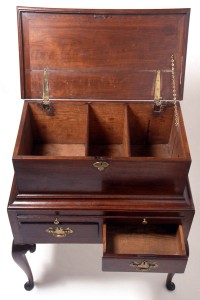 chests, sometimes also known as wine coolers, were made in fashionable designs and materials for elegant dining rooms or parlors. Some included compartments to hold six to ten round wine bottles.
chests, sometimes also known as wine coolers, were made in fashionable designs and materials for elegant dining rooms or parlors. Some included compartments to hold six to ten round wine bottles.
This North Carolina bottle case has a three-part compartment for wine and spirit bottles, other beverage wares, and perhaps sugar as well as drawers for storage and a pull-out shelf for workspace. Design and construction details suggest it may have been made by a craftsman who trained in Newport, Rhode Island, or was inspired by a Newport example.
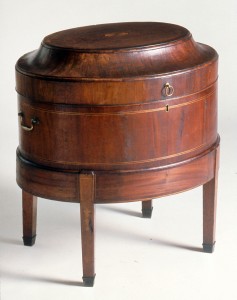
Wine cooler or cellarette
Winchester, Shenandoah Valley, Virginia; 1790–1805
Mahogany, black walnut, maple, brass, copper, lead
Bequest of Henry Francis du Pont 1957.698
This lockable cellarette has a copper lining with center drain, indicating it was at times filled with ice or cold water. It could also function as a cabinet for storing wine bottles or decanters.
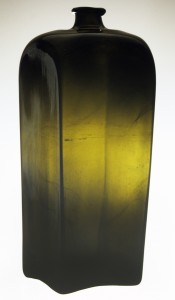 Case or gin bottle
Case or gin bottle
Continental Europe or England; 1770–1800
Glass (nonlead)
Museum purchase 1986.109
Continental Europe and England were the primary suppliers of flat-side “black glass” bottles used in America. Some sets were fitted in slotted, portable wooden cases. The bottles could be acquired already filled, as indicated by the 1764 inventory of Philadelphian Martin Ashburn, which states that five from his set of nine cased bottles were “full of Geneva [or gin].” Such references suggest that the traditional name of “gin bottle” for this form is justified, though records indicate that other liquids could have been stored in them. The bottle shown here was recovered from “[the] site of [the Revolutionary War] military encampment at Cooch’s Bridge near Newark, Delaware.”
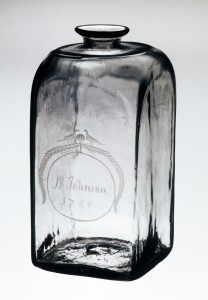 Case bottle
Case bottle
Probably John Frederick Amelung’s New Bremen Glassmanufactory
Frederick, Maryland; dated 1788|
Glass
Inscribed “B. Johnson / 1788”
Museum purchase 1973.357
Case bottle with other bottles and case from the same set
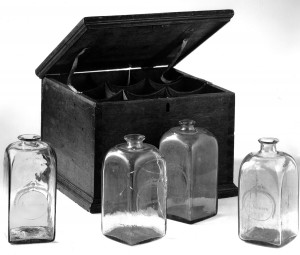 The above bottle is one of nine from a boxed set made for Colonel Baker Johnson of Frederick, Maryland. Johnson was a prominent lawyer, landowner, and promoter of manufactures. His brother, Thomas, was Maryland’s first governor. The bottle is attributed to Amelung, one of America’s best-known early glassmakers, but the composition is slightly different from other Amelung colorless glass.
The above bottle is one of nine from a boxed set made for Colonel Baker Johnson of Frederick, Maryland. Johnson was a prominent lawyer, landowner, and promoter of manufactures. His brother, Thomas, was Maryland’s first governor. The bottle is attributed to Amelung, one of America’s best-known early glassmakers, but the composition is slightly different from other Amelung colorless glass.
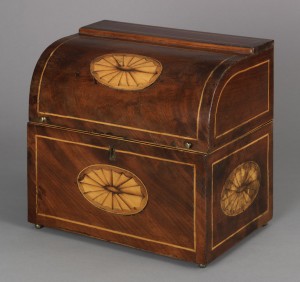
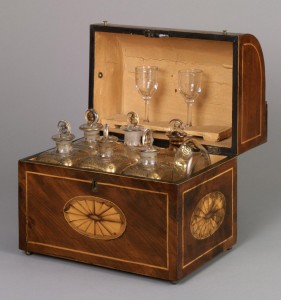
Bottle case
England (case) and Bohemia (bottles and glasses); 1800–1830
Mahogany, satinwood, white pine, brass, paper (case)
Glass (nonlead), gilding (bottles and glasses)
Bequest of Henry Francis du Pont 1959.2778a-j
As was true of larger cellarettes, the individual containers in more portable bottle cases might hold different types of alcoholic beverages. Thomas Sheraton’s Cabinet Directory (London, 1803) notes that bottle cases differ from “cellarets, wine cisterns, or sarcophagus” in that bottle cases have dividers that exactly fit the dimensions of specific bottles, which were often square or triangular.
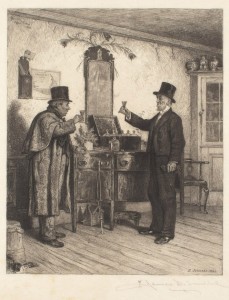 A Glass with the Squire
A Glass with the Squire
James David Smillie, after Eastman Johnson
New York, New York; 1886
Etching on wove paper
Museum purchase with funds provided by Special Funds for Collection Objects 1978.33
This print portrays one in a series of romanticized scenes on Nantucket Island, Massachusetts. Several elements in the scene, including the bottle case and sideboard, reappear in other views.
Related Themes:
